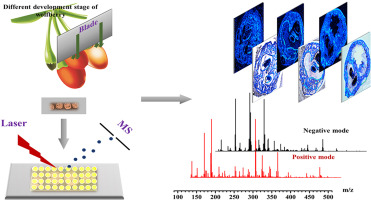Abstract
Wolfberry fruit has been attracting attention for centuries in Asian countries as a traditional herbal medicine and valuable nourishing tonic. Revealing the spatial distribution changes of important endogenous molecules during plant development is of great significance for investigating the physiological roles, nutritional and potential functional values of phytochemicals in wolfberry fruit. However, their spatial distribution information during fruit development has not been extensively explored due to the lack of efficient analytical techniques. In this work, matrix-assisted laser desorption/ionization mass spectrometry imaging (MALDI-MSI) was performed to visualize the spatial distribution of the endogenous molecules during fruit development. From the mass spectrum imaging, the choline, betaine and citric acid were distributed evenly throughout the entire fruit at all development stages. The hexose was distributed in the endocarp and flesh tissue, while sucrose was located in the seeds. Additionally, several phenolic acids and flavonoids were accumulated in the exocarp during fruit development, which indicated that they seemingly played protective roles in wolfberry fruit growth progress against abiotic and biotic stress. From the collected data, we found that the signal intensities of citric acid were decreased, while choline, betaine, hexose and sucrose were increased with fruit development. These results indicate that MALDI-MSI may become a favorable tool for studying of the spatial distribution and effective use of endogenous molecules, which provide a simple and intuitive way for authenticity identification, classification of drug food homologous foods and further understanding the physiological roles of endogenous molecules.
Wolfberry fruit has been attracting attention for centuries in Asian countries as a traditional herbal medicine and valuable nourishing tonic. Revealing the spatial distribution changes of important endogenous molecules during plant development is of great significance for investigating the physiological roles, nutritional and potential functional values of phytochemicals in wolfberry fruit. However, their spatial distribution information during fruit development has not been extensively explored due to the lack of efficient analytical techniques. In this work, matrix-assisted laser desorption/ionization mass spectrometry imaging (MALDI-MSI) was performed to visualize the spatial distribution of the endogenous molecules during fruit development. From the mass spectrum imaging, the choline, betaine and citric acid were distributed evenly throughout the entire fruit at all development stages. The hexose was distributed in the endocarp and flesh tissue, while sucrose was located in the seeds. Additionally, several phenolic acids and flavonoids were accumulated in the exocarp during fruit development, which indicated that they seemingly played protective roles in wolfberry fruit growth progress against abiotic and biotic stress. From the collected data, we found that the signal intensities of citric acid were decreased, while choline, betaine, hexose and sucrose were increased with fruit development. These results indicate that MALDI-MSI may become a favorable tool for studying of the spatial distribution and effective use of endogenous molecules, which provide a simple and intuitive way for authenticity identification, classification of drug food homologous foods and further understanding the physiological roles of endogenous molecules.

Keywords Plus:LYCIUM-BARBARUMPHENOLIC-COMPOUNDSORGANIC-ACIDSMALDI-MSLOCALIZATIONTISSUEPOLYSACCHARIDESL.
Published in TALANTA,Volume 234;10.1016/j.talanta.2021.122687,NOV 1 2021


